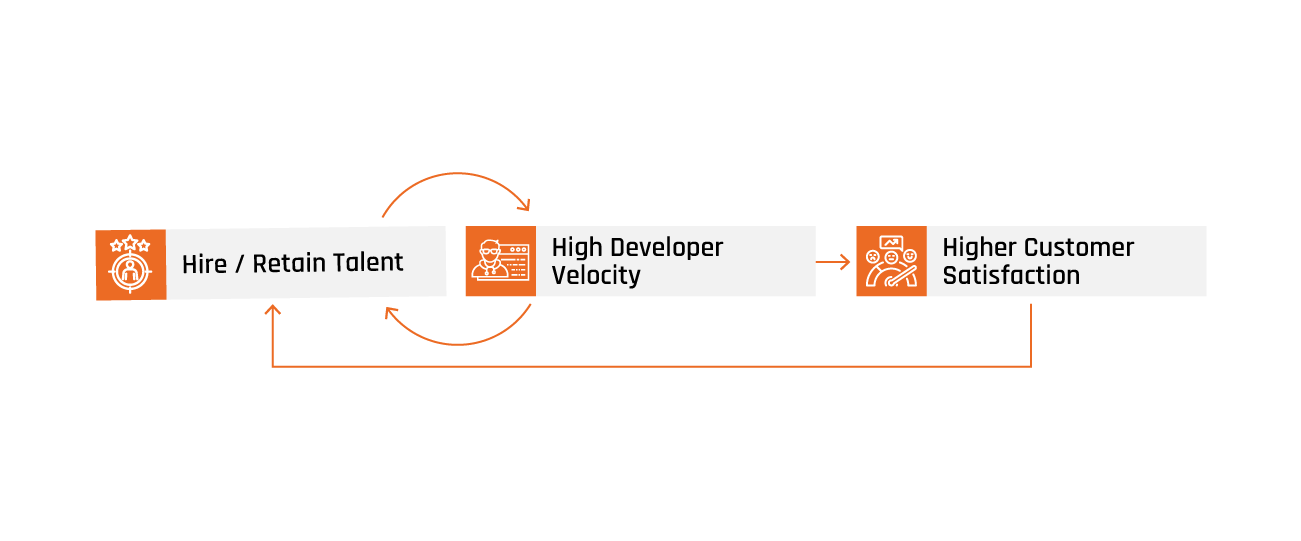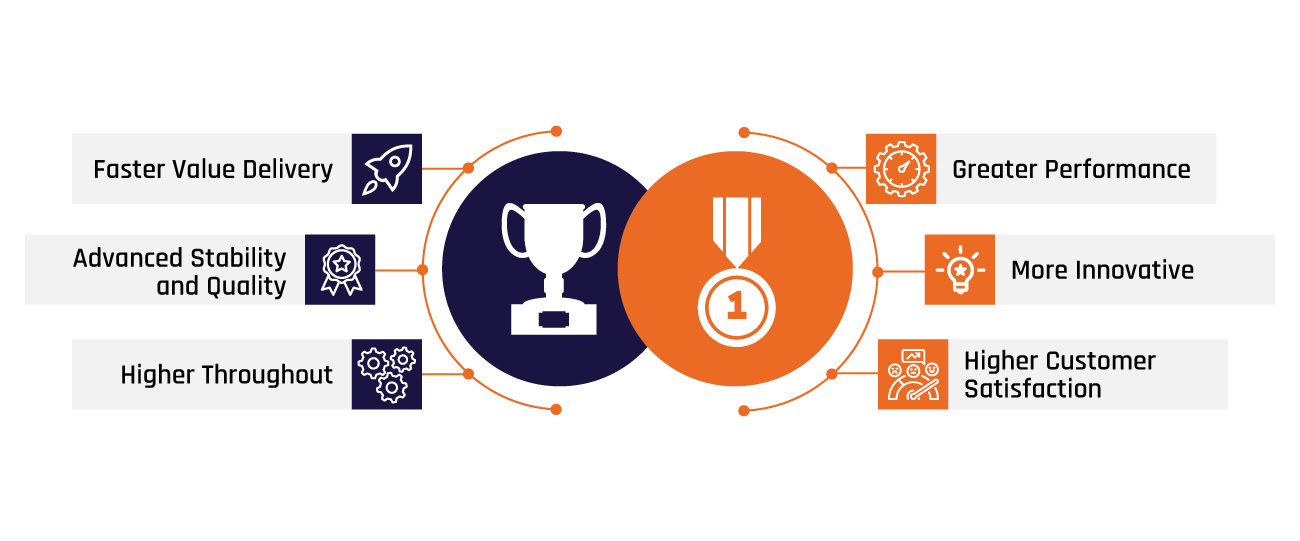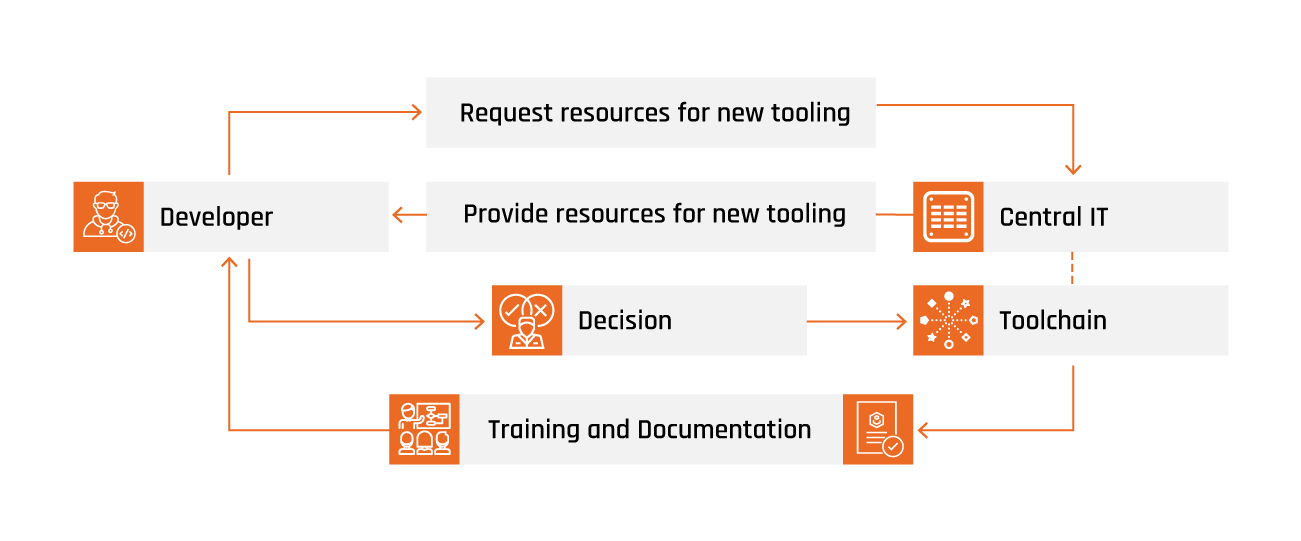One of our key principles at Xpirit is "people first". And this really means that people always come first in everything we do; it does neither imply money and shareholders are equally important nor that we have to find some kind of equilibrium. It means people always come first! And this does not only cover our own employees – it also includes the people that work for our clients.
From this people-centric culture evolved that we deeply care about developer productivity. In more than twenty years of experience working with developers, I’ve seen what it does to them if they feel productive or unproductive. I’ve seen people leaving companies because they did not feel productive, and I have seen teams thrive after implementing DevOps tooling and an and the joy that the people felt when they felt productive after a long time of unproductiveness. It was Satya Nadella, the CEO of Microsoft, that once said at a conference that he would always choose developer productivity over features for end-users, as the developer productivity benefits everyone and increases the feature delivery in the long run. This shows the importance of developer productivity to companies like Microsoft.
"If any engineer has to choose between working on a feature or working on developer productivity, always choose developer productivity" – Satya Nadella
The benefits of improved developer productivity
The question is: What will happen if your developers are not productive and have to work with old technologies and processes? The good developers will most likely leave sooner or later. This will leave you with the ones that don’t care or do not find another job easily. This will further reduce your entire productivity.
In the war of talent, when every engineer can get a new job at any time, a productive environment is crucial and a very important factor for people that are driven by intrinsic motivation – the talents you are looking for.
This wheel can spin in two directions: having a productive environment with a high developer velocity and satisfaction will help you to attract and retain talent. This will accelerate your developer velocity and productivity and attract other good engineers. If your environment is not productive, good people will leave and the velocity will decrease further and keep other good engineers from joining.
 Figure 1 – Developer velocity and the war on talent
Figure 1 – Developer velocity and the war on talent
And the increased productivity and increased quality in staff leads to better and more reliable software that gets shipped faster. This leads to faster feedback loops and makes you build the right things. In the end you achieve an increased customer satisfaction which further helps you to attract new talent.
 Figure 2 – Accelaration and customer satisfaction
Figure 2 – Accelaration and customer satisfaction
In April 2020 McKinsey published their research study about the Developer Velocity Index (DVI) (Srivastava S. & Trehan K. & Wagle D. & Wang J., 2020). It’s a study taken among 440 large organizations from 12 industries that considers 46 drivers across 13 capabilities. The study shows that the companies in the top quartile of the DVI outperform other companies in their market by four to five times. Not only on overall business performance – companies in the top quartile score between 40 and 60% higher in
- Innovation,
- Customer satisfaction,
- Brand perception and
- Talent management.
The findings align with the results from the DORA State of DevOps Report – but take them one step further by adding the business outcomes. The DevOps Report 2019 states that elite performers have compared against the low performers:
- Faster Value Delivery: they have 106 times faster lead time from commit to deploy.
- Advanced Stability and Quality: they recover 2,604 times faster from incidents and have a 7 times lower change failure rate.
- Higher Throughput: they do 208 times more frequent code deployments.
High-performance companies do not only excel in throughput and stability, they also are more innovative, have higher customer satisfaction, and a greater business performance.
 Figure 3 – Benefits of improved developer productivity
Figure 3 – Benefits of improved developer productivity
With this research in mind and the priority companies like Microsoft and Google give developer productivity, it is obvious that developer productivity should be a top priority for all companies that rely on software development.
The influence of the development toolchain on productivity
There are multiple factors that influence developer productivity. The most important ones besides people are:
- Culture
- Processes
- Toolchain
Having an engineering culture of trust and experimentation in which people are allowed to experiment and commit errors has a strong influence on developer productivity. But influencing or changing the culture is difficult. You cannot just write some values on a PowerPoint slide. The corporate culture is the result of the system, and you must change the entire system to change the culture. Nurturing a good culture should be an ongoing task, but it is not suitable to achieve results in the short or midterm.
This leaves processes and the toolchain. They go hand in hand. You can have the best tooling – if your processes are slow and heavy, your developer productivity will be low. But you can have great processes and do DevOps all the way – if you don’t have a toolchain to support it, the productivity will still be low. So, processes and the toolchain are the determining factors to increase the developer productivity in the short and midterm.
Governance and processes
The problem with the development toolchain is that it is very volatile. I’ve seen IT departments installing DevOps tooling (including build environments) and expecting it to be like a mail system: Install once and just run it for years with nearly no changes besides patches. But the many requests of development to install new tools and add-ins and manage different versions brought the team on their knees. This normally leads to one of two scenarios:
- The developer wild west: Developers are allowed to do everything. They get admin rights if necessary and are more or less responsible for the tooling themselves. The problem with this approach is that often there is also no alignment between the development teams. Each team uses the tools it wants and there is no maintained standard. This makes onboarding difficult and the allocation of teams to products not flexible.
- The IT castle: The IT department provides a bare minimum of tooling and is the gate keeper to production. Requests from developers are mostly ignored or declined. This approach normally leads to shadow IT and build servers under the desks of developers.
This is of course an exaggeration and oversimplification. But I’m sure some readers will recognize their company in one of the two extremes.
A good development toolchain must be embedded in the right amount of governance. Give the teams the freedom to experiment – but have a common standard that is documented and provide training and guidance.
It is ok if one team wants to use Angular even if the current standard is React. There might be good reasons for it. But the decision should be explicit. Maintaining two UI frameworks and providing guidance when to use which one increases the complexity and is therefore expensive.
A good governance process should look like this:
- Developers can request resources to experiment with new tooling at any time. In the cloud era this should be mostly a self-service and on demand.
- If the new tool is promising, there has to be an alignment with the other development teams and the team that provides the shared resources. Should the tool be added to the standard toolchain? Should it be supported? Should the usage be declined, or should it be handled as an exception? At the end it will be a decision that affects all teams!
- If the tool is added to the standard toolchain, the documentation must be updated. There should also be a training for the other teams and an updated onboarding training and/or documentation.
 Figure 4 – Example governance process for toolchain
Figure 4 – Example governance process for toolchain
In-sourcing or outsourcing
Due to the high impact on developer velocity and therefore business outcome, the first reaction normally is trying to in-source the toolchain and to manage the entire process on your own. And I think that’s absolutely valid if you have the resources and knowledge to do it.
But – as I mentioned before – a development toolchain is not another mail system that you install and run. If you don’t have the resources to manage it in a good way, it’s better to have someone do it for you that is specialized in that matter.
At the end, a good development toolchain will impact the performance of your business – but it will not impact your customers directly. If you changed the company that provides the service, your customers probably wouldn’t realize it.
That’s why we offer the complete development toolchain as a managed service. We call it the Managed DevStack. We can host it in a regional data center to allow complete data residency. The offering includes the complete DevStack – including build environments – and the governance process to manage changes. I think this is a good option, if you don’t have the resources or experience to host it yourself.
If you want to host it yourself, we can also help setting up the process, documentation, and trainings.
Conclusion
The impact of a good developer toolchain is enormous. It has a direct influence on developer productivity, and it is responsible if your development accelerates or slows down. It has a massive impact on innovation, customer satisfaction, brand perception, and talent acquisition.
But building and maintaining a healthy toolchain is not easy. It takes a lot of effort, experience, and a fine-tuned governance process. It’s better to seek help – or consume it as a good managed service – than providing a bad toolchain on your own.
Furter readings:
- Srivastava S., Trehan K., Wagle D. & Wang J. (April 2020). Developer Velocity: How software excellence fuels business performance.
- Forsgren N., Smith D., Humble J., Frazelle J. (2019). DORA State of DevOps Report
- Brown A., Stahnke M. & Kersten N. (2020). 2020 State of DevOps Report
- Forsgren N., Humble, J., & Kim, G. (2018). Accelerate: The Science of Lean Software and DevOps: Building and Scaling High Performing Technology Organizations (1st ed.) [E-book]. IT Revolution Press.





